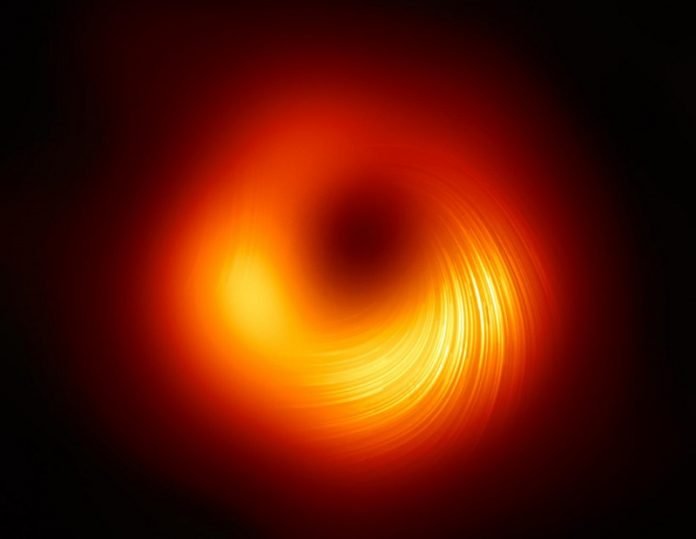
This is the first time scientists have imaged magnetic fields so close to a black hole.
Astronomers have now obtained a new view of the supermassive black hole at the center of galaxy M87.
Images released today by the Event Horizon Telescope (EHT) collaboration reveal how the black hole, some 55 million light-years away, appears in polarized light.
The image marks the first time astronomers have captured and mapped polarization, a sign of magnetic fields, so close to the edge of a black hole.
Scientists still don’t understand how magnetic fields — areas where magnetism affects how matter moves — influence black hole activity.
Do they help direct matter into the hungry mouths of black holes? Can they explain the mysterious jets of energy that extend out of the galaxy’s core?
In two studies published today in the Astrophysical Journal Letters, EHT astronomers reveal their latest findings and how magnetic fields may be influencing the black hole at the center of M87.
“One of the main science drivers of the EHT is distinguishing different magnetic field configurations around the black hole,” says Angelo Ricarte, a co-author and researcher at the Center for Astrophysics | Harvard & Smithsonian.
“Polarization is one of the most direct probes into the magnetic field that nature provides.”
The EHT collaboration has been studying the supermassive object at the heart of M87 for well over a decade.
In April 2019, the team’s hard work paid off when they revealed the very first image of a black hole.
Since then, the scientists have delved deeper into the data, discovering that a significant fraction of the light around the M87 black hole is polarized.
Light becomes polarized when it goes through certain filters, like the lenses of polarized sunglasses, or when it is emitted in hot regions of space that are magnetized.
In the same way polarized sunglasses help us see better by reducing reflections and glare from bright surfaces, astronomers can sharpen their view of the black hole by looking at how light originating from there is polarized.
Specifically, polarization allows astronomers to map the magnetic field lines present around the inner edge of the black hole.
“In order to gain confidence in our analysis, we used as many as five distinct methods to calibrate the data and reconstruct polarimetric images,” says Maciek Wielgus, a researcher at Harvard’s Black Hole Initiative and the Center for Astrophysics (CfA) who participated in the study.
“This huge team effort paid off as we found very good consistency between results obtained with all the different techniques.”
These new polarized observations of the M87 black hole are key to explaining how the galaxy is able to launch energetic jets from its core, the EHT team says.
One of M87’s most mysterious features is the bright jet of matter and energy that emerges from its core and extends at least 100,000 light years away. Most matter lying close to the edge of a black hole falls in.
However, some of the surrounding particles escape moments before capture and are blown far out into space in the form of these jets.
Astronomers don’t know how jets larger than the galaxy itself are launched from its core, nor how only certain matter falls into the black hole.
Now, with the new image of the black hole in polarized light, the team has looked directly into the region just outside the black hole where this interplay between inflowing and ejected matter occurs.
The observations provide new information about the structure of the magnetic fields just outside the black hole, revealing that only theoretical models featuring strongly magnetized gas can explain what astronomers are seeing at the event horizon.
“Magnetic fields are theorized to connect black holes to the hot plasma surrounding them,” says Daniel Palumbo, a co-author and researcher at the Center for Astrophysics.
“Understanding the structure of these fields is the first step in understanding how energy can be extracted from spinning black holes to produce powerful jets.”
To observe the heart of the M87 galaxy, the EHT collaboration linked eight telescopes around the world, including the Smithsonian Astrophysical Observatory’s Submillimeter Array, to create a virtual Earth-sized telescope.
The impressive resolution obtained with the EHT is equivalent to that needed to image a credit card on the surface of the Moon.
This unprecedented resolving power allowed the team to directly observe the black hole with polarized light, revealing the presence of a structured magnetic field near the event horizon.
“This first polarized image of the black hole in M87 is just the beginning,” says Dominic Pesce, CfA researcher and study co-author. “As the EHT continues to grow, future observations will refine the picture and allow us to study how the magnetic field structure changes with time.”
Sheperd Doeleman, founding director of the EHT, added, “Even now we are designing a next-generation EHT that will allow us to make the first black hole movies. Stay tuned for true black hole cinema.”
The EHT collaboration involves more than 300 researchers from across the globe and includes 30 scientists and engineers at the Center for Astrophysics | Harvard & Smithsonian.



